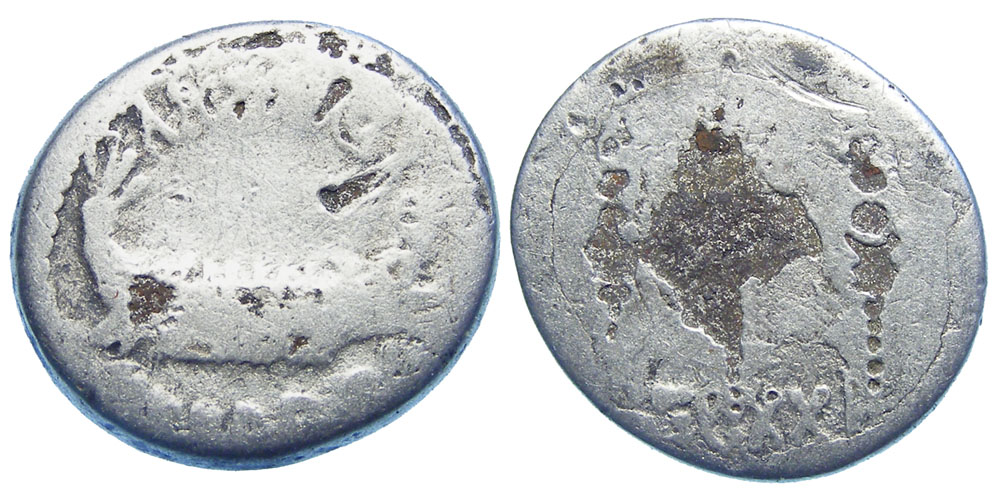
At first glance this looks like a fairly common Legion XXI denarius of Mark Antony but highly worn and somewhat corroded. On closer inspection there is more too this coin as it has some unusual features.
Fourree is a French word meaning filled which in numismatics describes a coin with higher purity silver (and occasionally gold) foil over a baser metal core. In most cases that core is copper alloy and on some gold fouree can be lead. There are also some rare instances of bronze fouree over iron. Nearly all fourree are the work of ancient counterfeiters intending to pass them as solid metal coins. There is debate of possible official fourree coins, but other than the emergency tetradrachma of Athens at the end of the Peloponnesian war, possibly Claudius fourree denarius found in England (which are questionable) I personally believe all fourree coins are ancient counterfeits.
On silver coins most fourree have silver foil wrapped around a copper alloy core, often with a layer of solder in between. The solder would have been applied before the wrap and then melted into a joint after. The joint in the foil wrap can be anywhere on the coin, often on the edge but it can be in the middle as with this coin with two over lapping sheets of foil. On some fouree the joint can be difficult to see.
This coin shows a very clear joint where the fourree maker started with two sheets, one larger than the other. The smaller sheet was placed on the reverse. The larger sheet was placed over the obverse and wrapped around the edges until it overlapped the reverse sheet appearing as an irregular but circular line seen only on the reverse. Either during striking, or possibly by hammering flat prior to striking the joint was flattened. I have not tested for solder but as the sheets are firmly attached to the core there likely is a solder layer. While clearly visible now, I suspect when freshly minted, prior to the wear and weathering, it was not so obvious.
This joint leaves no doubt this is an ancient fourree, not just a deteriorated and corroded official coin.
Wear and deterioration of the coating has exposed large areas of the core, which is the most unusual feature of this example :
While most fourree with a core exposed have a copper alloy core, this core is baser silver (billon) with either badly mixed silver and copper or the silver and copper have separated due to crystallization, and possibly both. There is a fairly large blob of oxidized copper (cuprite) which is how the entire core would look if this were just a copper core.
One might ask why a counterfeiter would reduce his profit by using a base silver core rather than just copper. A possible answer would be he was working in a time and place where banker's stamps were applied to coins looking for evidence of a copper cores, and such stamps are common on Mark Antony denarii. While a heavy banker's stamp could easily expose a copper core, with this billon core it might look normal, reducing the forgers risk of being caught as he passed it into circulation.
The coins specifications are :
Weight: 2.78 grams. The coin appears very worn with enough of the plate missing to assume it was heavier, probably between 3.0 and 3.1 grams, when minted.
Size: 15.5 x 17.3 mm.
Thickness: 1.7 mm
Purity: While impossible to determine the exact purity of the core without better testing than I can do here, the visual appearance of the core and the separation of the silver and copper suggest an alloy of somewhere between 20 and 25% silver.
Official Mark Antony Legionary denarii are about 82% silver and range from about 3.1 to 3.85 grams, with most examples between 3.5 to 3.7 grams. A counterfeiter picking 100 official coins averaging 3.75 grams out of circulation could melt them and add enough copper to that alloy to many about 397 new flans of 25% silver at 3.1 grams, a roughly 400% profit margin.
1) The style of this coin is pretty good and if mixed in with a larger group of official coins would not jump out at you as counterfeit because of the style.
2) At 3.0 to 3.1 grams when minted it is not enough lighter weight than the lowest weight official coins to create concern.
3) The foil coating when new without breaks would have the look and feel of the higher purity official coins.
4) The billon core dramatically reduces the risk of detection via test via bankers stamp.
It is very likely this coin would have passed as genuine when new, and from the amount of wear on it, it appears to have passed for a long time. The counterfeiter was making a 400% profit, with nearly no risk.
I discovered this example about 2004, and had it set side for years before documenting it here. In recent years I have become aware of handful of others like it with billon cores. I suspect there are many more of them still passing as official ancient coins because the plating is still intact.
| |

© 2012-2021 R & T Enterprises Ltd.
|
 |
| 


